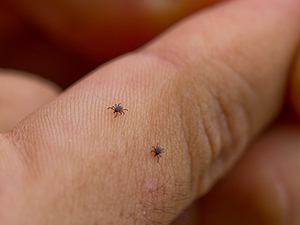It’s tick season!
Deer tick bites can transmit Lyme disease – a bacterial infection that can cause fever, headache, and fatigue, and, if left untreated, can spread to joints, the heart, and the nervous system.
The time for greatest concern is late spring and early summer when ticks are in their nymph stage. So if you’re out enjoying nature, it’s important to take steps to protect yourself.
Preventing tick bites
- Avoid walking through high grass and bushy areas. If you’re hiking, stay on trails.
- Use insect repellent labeled for ticks (not appropriate for infants; follow instructions for use on children).
- Wear light-colored clothing, and – to minimize skin exposure – long pants (with pants tucked into your socks) and long-sleeved shirts.
- After outdoor activity, check yourself for ticks, paying close attention to the back of the knees, behind the ears, scalp, arm pits, and back. Check children and pets, too.
If you find a tick on you
- If the tick isn’t attached, just brush it off. If you’re at home, you can wrap it in tissue and flush it down the toilet.
- If the tick has bitten you, carefully remove it with tweezers. Grasp it by the head or mouth parts right where they enter the skin (do not grasp the tick by the body), and without jerking, pull firmly and steadily outward [see a diagram from the CDC here].
- Identify the tick (or take a picture of it) so you know what you're dealing with: different kinds of ticks carry different risks [see types of ticks here].
- Wrap it in tissue and flush it down the toilet, then clean the bite area and your hands with rubbing alcohol or soap and water.
- Do not use pepperment oil, nail polish, petroleum jelly, or heat to try to remove the tick – these can actually increase the chances of Lyme disease transmission.
Not all ticks are infected, and in order to transmit Lyme disease, an infected deer tick must be attached for at least 24 to 36 hours. But any time you’re bitten by a tick, you should pay attention to possible signs of Lyme disease – especially a rash at the site of the bite. (See more below).
Taking antibiotics within three days after a tick bite may be beneficial for some people. This would apply to deer tick bites that occurred in areas where Lyme disease is common and there is evidence that the tick was attached for more than one day. In cases like this you should discuss the possibilities with your doctor or licensed health care provider.
Signs and symptoms of Lyme disease
Early signs of Lyme disease can include:
- A rash at the site of a tick bite, which generally appears two days to one month after the bite. It is often (but not always) bulls-eye shaped, and grows, does not itch, and is not painful.
- Flu-like symptoms such as fever, chills, exhaustion, stiff neck, headache, and joint pain.
When to seek medical help
- If you discover a bulls-eye shaped rash anywhere on your body – whether or not you are aware of a tick bite.
- If you experience fever or flu-like symptoms after a known tick bite.
Testing and treatment
Most cases of Lyme disease can be treated successfully with antibiotics. The infection is diagnosed based on symptoms (including a rash) and the possibility of exposure to infected ticks. Laboratory testing can be helpful, but is not always conclusive.
If you’re concerned about a tick bite or possible Lyme disease symptoms, schedule an appointment with a Cornell Health provider.


